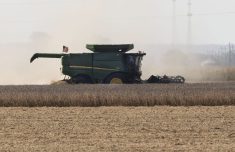By Pavel Polityuk and Polina Devitt
KIEV/MOSCOW, March 12 (Reuters) – Sowing of spring grains in Ukraine is under way in almost ideal weather but there is concern about farmers facing financing problems and parts of the Crimea region may remain fallow, traders and officials said.
Political crisis in Ukraine and Russia’s bid to reclaim Ukraine’s southern region Crimea have weakened the local hryvnia currency by 12 percent since the start of 2014 and forced some banks to cut lending. Hryvnia-denominated costs for buying seeds, fertilisers and fuel have risen.
Read Also

U.S. livestock: Feeder cattle hit contract highs on tight supply
Chicago | Reuters – All Chicago Mercantile Exchange feeder cattle futures and most live cattle futures hit contract highs on…
Ukrainian agriculture minister Ihor Shvaika said this week that farmers needed additional financing of 8 billion hryvnia ($860 million) to complete spring field works and prepare for harvesting.
“There is one significant risk – our banks decline to finance farmers,” said a large foreign trader who works in Ukraine. “It could cause a switch from more expensive grains like maize (corn) to cheaper ones, like barley or sunflower.”
Ukrainian farmers have been selling grain from last year’s stock to address cash flow problems, traders said last week.
Shvaika said farmers had been able to buy the seeds they need and have fuel despite rising prices.
Officials and analysts still expected Ukraine, one of the world’s key maize (corn) exporters, to harvest its second largest grain crop in 2014.
PERFECT WEATHER
“Weather conditions are perfect,” said Yelizaveta Malyshko from UkrAgroConsult consultancy. “Early spring means that the grain yield could be high and our forecast is 59-60 million tonnes of grain this year.”
The consultancy said Ukraine harvested 56.6 million tonnes of grain last year while the government put the volume at 63 million tonnes in 2013.
Most of Ukrainian winter grain crops had been in good or satisfactory condition and the outlook for the 2014 harvest is positive, Shvaika said. He declined to provide details.
The ministry said last month farms planned to increase the area under maize to 5.1 million hectares from 4.9 million hectares in 2013. The area under wheat could fall to 6.4 million hectares from 6.6 million hectares a year earlier.
It said the 2014 overall grain sowing area could total 16.5 million hectares, including 8.6 million of winter grains. Farms have already sown a total of 106,000 hectares or 1.2 percent of the area planned for spring grains.
Most of the spring grain area in Crimea, which covered 1.2 percent of Ukraine’s 2013 grain crop, is likely to remain unsown due to a lack of fuel caused by the turmoil, according to Ukraine’s Agriculture Ministry. Crimea sowed around 480,000 hectares with grain in 2013.
“There are political risks for sowing campaign – these risks are called Crimea,” Shvaika said. There are no problems with sowing in other parts of Ukraine, he added.
“We have information that one of Ukraine’s biggest holdings will not sow around 40,000 hectares in Crimea because of the turmoil,” a Ukrainian trader said.
SPRING GRAINS SOWING IN RUSSIA
Russia’s southern regions started the early-spring grain-sowing campaign early last week. The agriculture ministry expects the country to sow 31.8 million hectares for spring grains this year, up 500,000 hectares year-on-year.
The country has sown 14.7 million hectares for winter grains, down 900,000 hectares on a year before. According to the ministry, 96 percent of winter grain plantings are in good or satisfactory condition after winter, which is better than the average figure over recent years.
There are some concerns over low soil moisture in certain regions of the European part of Russia, making plantings more dependent on future precipitation, Sovecon analytical firm said previously. It expects Russia’s 2014 grain crop to be 86 million tonnes.
However, Russia’s state weather forecaster Hydrometcentre expects snow during nights to help regions with a lack of moisture in soil in coming days. It sees about 95 percent of winter grain plantings in good or satisfactory condition after winter.
Russia’s Agriculture Ministry has targeted an increase in the 2014 grain crop to 95 million tonnes, including 55 million tonnes of wheat, from 91.3 million last year.
















